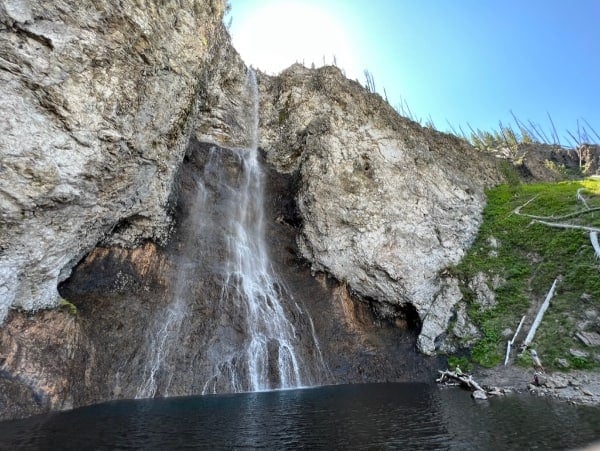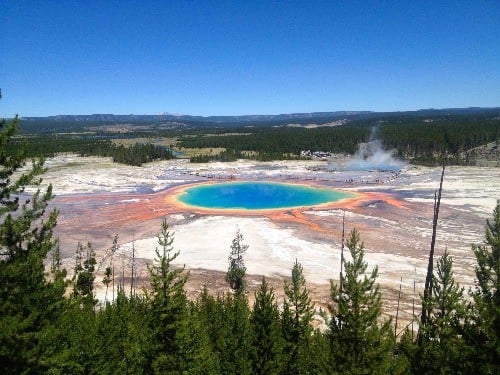
Along with Old Faithful and the Grand Canyon of the Yellowstone, one of the things you MUST see in Yellowstone is the Grand Prismatic Spring. In this article, I’ll cover everything you need to know about it.
The Grand Prismatic Spring is the largest hot spring in Yellowstone and the third largest in the world. It is over 300 feet long, 200 feet wide, and 100 feet deep. It gets its name from the colorful edges — resembling a light prism — with blue, green, yellow, orange, and red color rings.
The Grand Prismatic is a hot spring.
In Yellowstone, there are five kinds of geothermal features: hot springs, geysers, fumaroles, mud pots, and travertine terraces. They are all closely related — mostly having to do with water being heated underground and working its way to the surface.
The big difference between a hot spring and a geyser is the plumbing. Geysers have a constriction, or a bottleneck, causing the water to get trapped, build pressure, and explode!
Hot springs don’t have the constriction. So hot water rises to the top, cools, and returns to the bottom. The water circulates freely.
Some hot springs used to be geysers, but something happened to alter the constriction, like an earthquake or a massive eruption.
There are only two bigger hot springs in the world: Frying Pan Lake in New Zealand and Boiling Lake in Dominica. The Grand Prismatic is 370 feet in diameter and over 120 feet deep.
At Yellowstone, it’s common to walk around on boardwalks and look down into deep blue hot springs. There are several gorgeous springs.
Grand Prismatic is a little different because you can’t get close enough to look down into it. Rather, it’s more like you’re looking out over a steaming pond or mountain lake. In fact, in the early days, it was also called Prismatic Lake or Emerald Lake.
For that reason, some people don’t seem too impressed by it. It is hard to take it all in. It’s why you need to see it from next to the spring and from above (see below).
It’s named Prismatic because it has the colors of a light prism. The colors are actually millions of tiny organisms called thermophiles (“thermo” = heat; “phile” = lover).
These organisms can ONLY live in hot temperatures — until it gets too hot even for them. The temperature will determine which organisms can survive, and therefore what colors we see.
The center of the hot spring is a deep blue — it’s too hot for any organisms to survive. As the water moves towards the edges and flows out of the hot spring, it cools, changing the colors from green to yellow to orange to red to brown.
When you see it from a higher viewpoint, it looks like a big eye. Almost like Sauron in Lord of the Rings — but not as spooky. It’s the one hot spring to rule them all!
There are two ways to see it: next to it and from above.
It has its own parking lot: the Grand Prismatic Spring parking lot. You’ll walk on the bridge crossing the Firehole River and continue on the boardwalk.
It makes a loop around the Midway Geyser Basin and continues along the edge of the Grand Prismatic for a while.


To see it from above you need to park at the Fairy Falls parking lot. Take the Fairy Falls hike.
The Fairy Falls hike is about 5.5 miles round trip, but you only need to walk the first 0.5 miles before turning left to the Grand Prismatic Spring Overlook. Walk another 0.3 miles and you’ll arrive at a viewing station.
This viewpoint has exploded in popularity lately. In fact, it wasn’t even an official viewpoint until 2017.


If you would like a step-by-step guide for seeing Grand Prismatic, as well as the rest of Yellowstone, check out our Yellowstone Itinerary & Audio Guide.
It’s located in the Midway Geyser Basin. This is located between Madison Junction and Old Faithful.
This general area of the park is composed of (from North to South): Lower Geyser Basin, Midway Geyser Basin, and Upper Geyser Basin.

Notice they are named after their elevation, not their direction. So Upper Geyser Basin (which contains Old Faithful) is the lowest on the map.
Midway is the smallest of the basins. It contains:
Like Florida Man, Yellowstone Visitor is always up to something bizarre.
In 2014, the National Park Service banned drones from all national parks. Just two months later, a tourist from the Netherlands crashed his drone into the Grand Prismatic Spring.
The park service was very concerned it could damage the colors of the spring, something that happened to Morning Glory spring after people threw debris in it over the years.
The park service looked at all sorts of options to retrieve the drone but to no avail. The drone still sits at the bottom. The tourist was fined over $3,000.
Download our Free Quick and Easy Guide to Yellowstone’s entrances!
Imagine the huge Grand Prismatic as a geyser — that’s basically what the nearby Excelsior Geyser used to be.
It’s almost the size of Grand Prismatic, and it used to erupt in massive explosions that were 300 feet wide and 300 feet tall! Imagine!
This geyser became famous after the park was created in the late 1800s, as the explosions were unlike anything ever seen.
Unfortunately, the geyser eruptions slowed down, and they became dormant by 1900. Since it really isn’t a geyser anymore, it’s called Excelsior Geyser Crater.
Remarkably, there is one known photo of this geyser erupting. In 1888, park photographer Frank Jay Haynes snapped a photo of this event.
CHECK OUT: 25 Absolute Best Things To Do in Yellowstone

Yellowstone is crowded!
Need a game plan to avoid the crowds? Check out our itinerary.
Most travelers want to visit the most popular sites and still avoid the crowds. We have a detailed itinerary that gives you a step-by-step game plan so you can get to the best places at the right times.
But that’s not all! Our itinerary includes a free audio guide to listen to while driving with over 3-hours of stories about the park!
YELLOWSTONE TRIP PLANNER: To read or watch all of our content about Yellowstone National Park, check out our Yellowstone Homepage
ENTRANCES: Yellowstone has 5 entrances: The West Entrance, the East Entrance, the Northeast Entrance, the North Entrance, and the South Entrance. Learn which entrance to Yellowstone is right for you with our Free Quick and Easy Guide
THINGS TO DO: Don’t miss all that Yellowstone has to offer including Old Faithful, the Grand Prismatic Spring, Yellowstone Lake, Norris Geyser Basin, Mammoth Hot Springs, and West Thumb and Grant’s Village
GREAT CITIES TO STAY OR CHECK OUT: Learn all about where to stay and where to camp when visiting Yellowstone and things to do in Cody, Wyoming, and other areas surrounding Yellowstone
WHERE TO EAT: Check out the best places to eat including the Old West Dinner Cookout and also where to get groceries and eat picnics in Yellowstone National Park
KNOW BEFORE YOU GO: Find out if you need a reservation or bear spray and binoculars, as well as tips for driving in and flying to Yellowstone
WATCH: Enjoy videos of gorgeous Yellowstone National Park while learning our best tips for visiting by watching our Yellowstone YouTube Playlist
This site is a participant in the Amazon Services LLC Associates Program, an affiliate advertising program designed to provide a means for sites to earn advertising fees by advertising and linking to Amazon.com. We are compensated for referring traffic and business to Amazon and other companies linked to on this site.
Receive weekly newsletters updating you on the Best of the West including: essential travel tips, park updates, stories, and our favorite things to see and do.